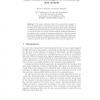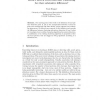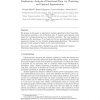3133 search results - page 91 / 627 » Representing clusters for retrieval |
100
click to vote
CVPR
2009
IEEE
16 years 5 months ago
2009
IEEE
Recently a large amount of research has been devoted to
automatic activity analysis. Typically, activities have been
defined by their motion characteristics and represented by
t...
ICMCS
2008
IEEE
15 years 4 months ago
2008
IEEE
We investigate the symmetric Kullback-Leibler (KL2) distance in speaker clustering and its unreported effects for differently-sized feature matrices. Speaker data is represented a...
WILF
2007
Springer
15 years 4 months ago
2007
Springer
Two major problems related the unsupervised analysis of gene expression data are represented by the accuracy and reliability of the discovered clusters, and by the biological fact ...
DAGSTUHL
2004
14 years 11 months ago
2004
Abstract. The starting point of this work is the definition of local pattern detection given in [10] as the unsupervised detection of local regions with anomalously high data densi...
CORR
2010
Springer
14 years 10 months ago
2010
Springer
We propose in this paper an exploratory analysis algorithm for functional data. The method partitions a set of functions into K clusters and represents each cluster by a simple pr...



